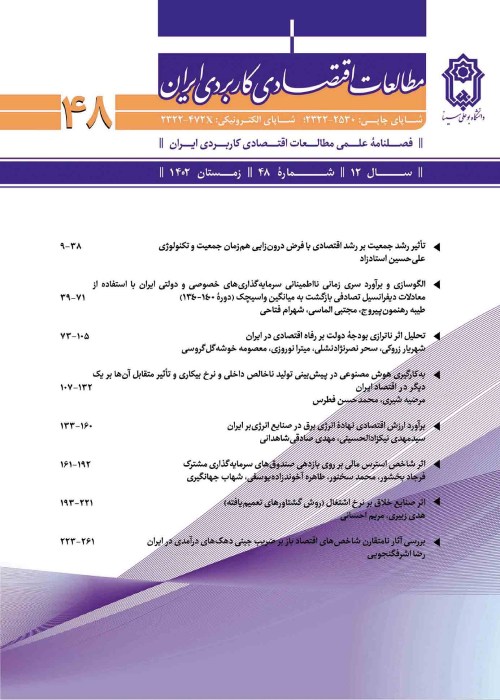Effect of Financial Development and Business Cycles on Bank Risk in Iran
Author(s):
Article Type:
Research/Original Article (دارای رتبه معتبر)
Abstract:
Banks as the financial institutions of the economy have a significant role in the financial intermediation. Therefore, savings, investment, production, employment and growth in the national economy are affected by the decisions and proceedings of the banks. Lending credits have been always considered as the main function of the banks and the change of the economic circumstances can affect the banking risk. As the repayment of the borrowers may decrease over time, the main issues that all banks usually face with are credit risk and non-performing loans. One of the most serious challenges that the countrys banking system is facing with in recent years has been the increasing amount of uncollectible bank debt and non-performing loans. Banks in Iran have too much non-collectible corporate debt on their books. This is due to the bank-centered financial and monetary markets of the country, and the most significant role of banks in creating credit and the liquidity in the country. At present, most of the banks in Iran are facing with lack of resources which has greatly been reduced their ability to finance the projects and boost banking resources. This has led to an increase in bank bankruptcy probability. Considering the above mentioned factors, identifying the factors affecting bank credit risk is very important. Business cycles and financial development are considered as two main factors which affect the credit risk and non-performing loans. Business cycles are a kind of systematic fluctuations in macroeconomic activities of countries that are often emerged by firms business activities. A cycle with a period of economic prosperity, which simultaneously occurs in various economic activities, begins and ends with a period of stagnation and contraction. These changes are repeated over and over again, and varying from one year to several years. Therefore, the credit risk of banks is closely related to business cycles, because during the recession, the bank leverage is low, and it is high during the boom period. During the economic boom, banks offer more facilities to businesses and reduce new loans in times of economic downturn. The other main factor affecting the credit risk and non-performing loans is financial development. Financial markets in which debt and financial assets are exchanged are channels for saving that are influenced by technical and general changes, as well as changes in laws and regulations. The set of factors, policies and institutions that lead to deep and extensive access to financial services will lead to financial development. The development of financial markets, with a positive impact on economic activity, will increase the productivity of financial services, risk management, allocation of capital and resource mobilization. Financial markets can play an important role in economic growth, since financial efficiency transfers capital from savers to borrowers and directs resources to productive and profitable investment projects. Of course, the development of financial markets for the economy involves opportunities and threats, because on the one hand, by optimizing the allocation of capital, firms increase the opportunity for economic growth, but on the other hand it can risk the financial system. Therefore, the purpose of the current study was to investigate the effects of financial development and business cycles on the credit risk of the banks for a selection of Iranian banks during the period from 2006-2014 using panel data approach and Eviews software. The model of the research is the modified model of Vithessonthi and Tongurai (2016). The integration and cointegration tests showed that the variables are integrated and there are a significant long-run equilibrium relationship among these variables. The results of the study using panel data and fixed-effects model indicated that financial development and business cycles have negative effects on the credit risk of the banks.
Keywords:
Language:
Persian
Published:
Quarterly Journal of Applied Economics Studiesin Iran, Volume:7 Issue: 26, 2018
Pages:
71 to 87
magiran.com/p1845524
دانلود و مطالعه متن این مقاله با یکی از روشهای زیر امکان پذیر است:
اشتراک شخصی
با عضویت و پرداخت آنلاین حق اشتراک یکساله به مبلغ 1,390,000ريال میتوانید 70 عنوان مطلب دانلود کنید!
اشتراک سازمانی
به کتابخانه دانشگاه یا محل کار خود پیشنهاد کنید تا اشتراک سازمانی این پایگاه را برای دسترسی نامحدود همه کاربران به متن مطالب تهیه نمایند!
توجه!
- حق عضویت دریافتی صرف حمایت از نشریات عضو و نگهداری، تکمیل و توسعه مگیران میشود.
- پرداخت حق اشتراک و دانلود مقالات اجازه بازنشر آن در سایر رسانههای چاپی و دیجیتال را به کاربر نمیدهد.
دسترسی سراسری کاربران دانشگاه پیام نور!
اعضای هیئت علمی و دانشجویان دانشگاه پیام نور در سراسر کشور، در صورت ثبت نام با ایمیل دانشگاهی، تا پایان فروردین ماه 1403 به مقالات سایت دسترسی خواهند داشت!
In order to view content subscription is required
Personal subscription
Subscribe magiran.com for 70 € euros via PayPal and download 70 articles during a year.
Organization subscription
Please contact us to subscribe your university or library for unlimited access!



